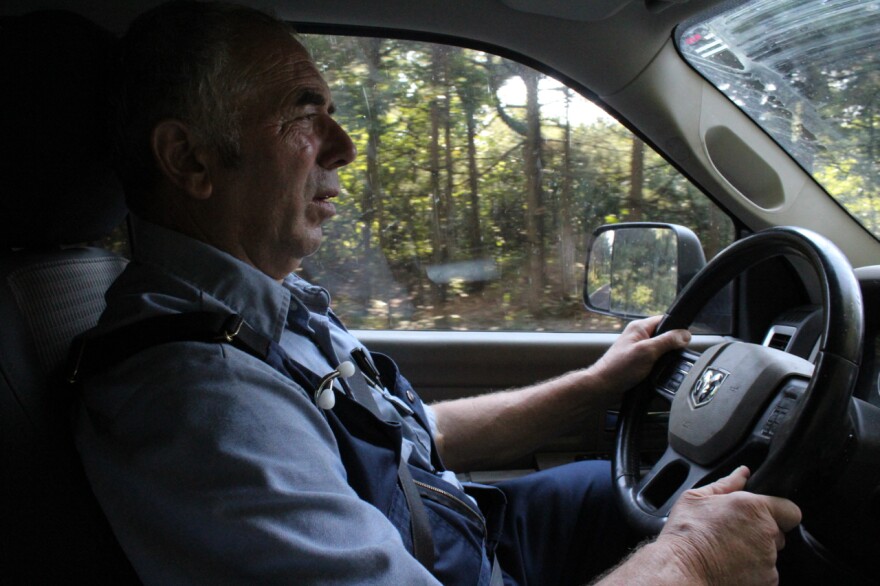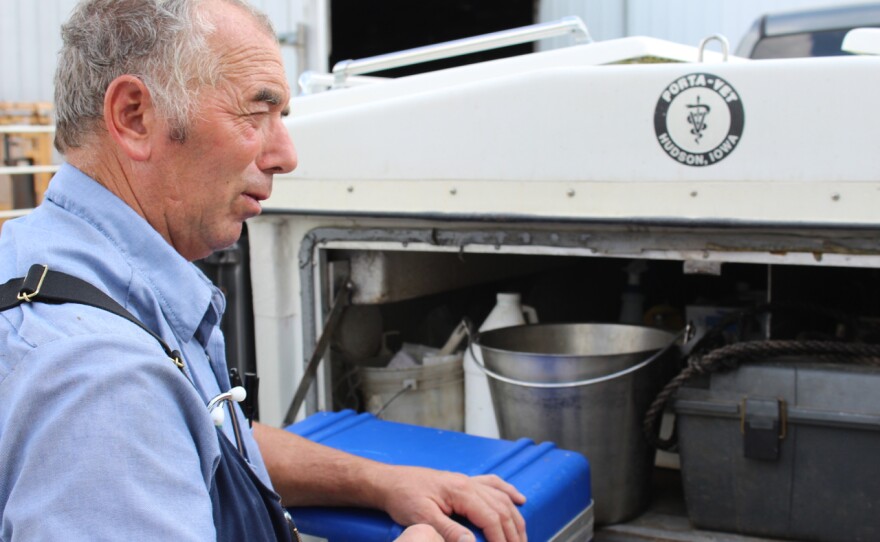
Indiana has a shortage of farm veterinarians -- and that strain could get worse in January when new rules for food animal antibiotics use take effect.
The change will mean more demand for veterinarians in rural Indiana.
One of those vets is Tom Troxel. He takes care of dairy cows, and he and his wife Luann also run a small dairy farm in LaPorte County.
By just before 8 a.m., the first part of their day is already over: the cows have been milked, and Luann is feeding the last of the calves.
"So these calves are just a few weeks old," she says. The babies moo as she holds up a bucket for them to drink from. "They're getting milk – real milk."
"At one time, I would have gone by six dairies to get to this one. Now I went by one dairy to get to these six."
The Troxels have raised cows for decades, but they're selling the herd this fall to make more time for their old-fashioned farm vet business. Luann Troxel is administration, and Tom Troxel is the vet.
He's getting in his truck to make house calls. The first is 40 minutes away.
"At one time, I would have gone by six dairies to get to this one dairy here," he says as he drives down county roads into Starke County. "And now I went by one dairy to get to these six."
A Dying Breed
Tom Troxel works for small farms, since big food companies often employ their own vets. And with consolidation in agriculture, he says, the little guys are fewer and farther between.
"It means more windshield time, which isn't billable," he says. "And besides that, we've always tried to educate our farmers and teach them how to do what we do and how to make the right diagnosis, and … now the farmer has the tools and the ability to do that himself."
Finally, he pulls into J&S Dairy in Pulaski County. It's one of those last few small farms.
"See, now, these people here are survivors," Tom Troxel says.
This farm is owned by Mike Weldon's two sons. Weldon says these days, vets like Tom Troxel are hard to find.
"There's a lot of vets, but none of 'em wanna do large animals."
"There's a lot of vets, but none of 'em wanna do large animals," Weldon says. "They all wanna do dogs and cats – that way everything can come to their office and they don't have to drive around the country."
It's also about money. The average starting salary for a doctor of veterinary medicine in the U.S. was $71,000 last year. But average student debt was more than twice that. And equipment, medicine and licenses can get expensive in rural places where there aren't many clients.
'Eyes And Ears'
But Indiana State Veterinarian Bret Marsh says it's still important to everyone to have them there.
"One of the things that we rely heavily upon a private veterinary practitioner is, they're the eyes and ears for events that are going on in animal populations throughout our state," Marsh says.
He's talking about disease outbreaks, such as 2015's avian flu that decimated commercial poultry flocks in the Midwest. And the risk isn't limited to big farms, Marsh says a vet in Southeast Indiana recently found tuberculosis in a herd of just 18 cattle, which all had to be euthanized.
But in 25 Indiana counties, there are no food animal vets at all -- and many other counties have huge numbers of animals per vet (see map below). So the 200 or so vets Indiana does have do a lot of driving. And starting in January, they'll need to do even more.
New federal antibiotics regulations focus on forbidding farmers from using drugs that matter in human medicine to make animals grow fast.
But the rules will also require vets to do on-farm inspections and write prescriptions for everything else, including some drugs farmers used to get over the counter.
"[That] may mean that more vets are going to be needed by an area which may have been surviving just fine with one," says Danielle Tack, who oversees the USDA's Veterinary Medical Loan Repayment Program.
It identifies rural vet shortage areas – Indiana's are in the Southeast and West Central regions – and pays off some student loans for vets who set up shop there. Those vets can get $75,000 over three years if, in Indiana's case, they'll spend at least a third of their time on food animals.
But out of nearly 200 shortage areas nationwide, Tack says her program can only afford to help 45 vets a year. Since 2010, only six of those have been in Indiana, and she says their funding isn't likely to increase.

Somebody's Gotta Do It
That means things won't change anytime soon for folks like Tom Troxel. At J&S Dairy, he's doing some very hands-on cow ultrasounds.
This is a messy, smelly job: Troxel is wearing boots, coveralls and a plastic glove all the way up his arm. The cows crowd together as he tries to get one into a metal pen to do the ultrasound.
"They're talking among themselves, as they shouldn't be doing," he jokes as he corrals the skittish cows. "They're telling how awful this procedure is."
Sparing you the gory details, it's not that bad, and it's not long before the cows get to mosey away again, to eat lunch in their sunny yard.
This is a messy, smelly job.
Farmer Sam Weldon says sometimes, Dr. Tom finds a sick animal when he visits. Other times, he just tells the farmers they're doing a good job.
"Yep, we like seeing Doc once a month," Weldon says.
But Troxel has to get back on the road, to his next appointment. He's got many miles – and cow ultrasounds – ahead of him.











